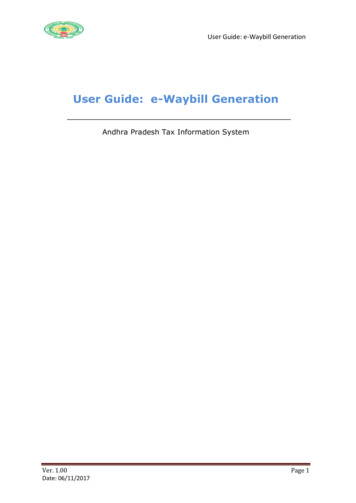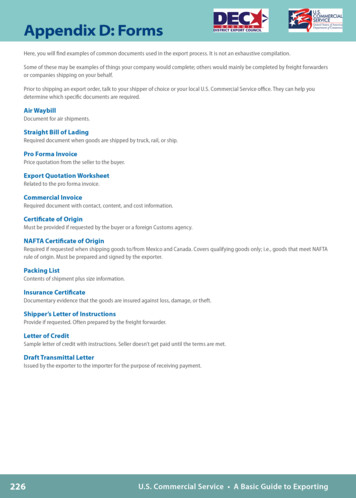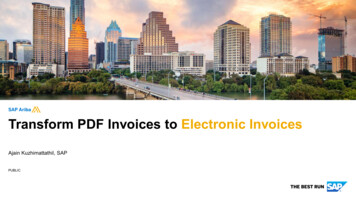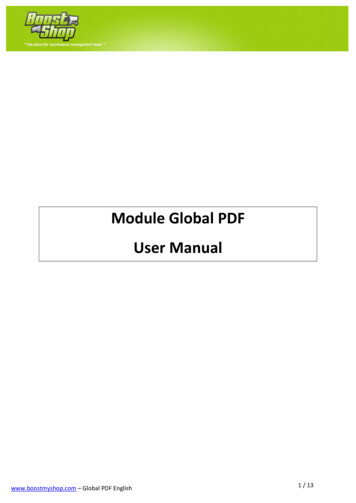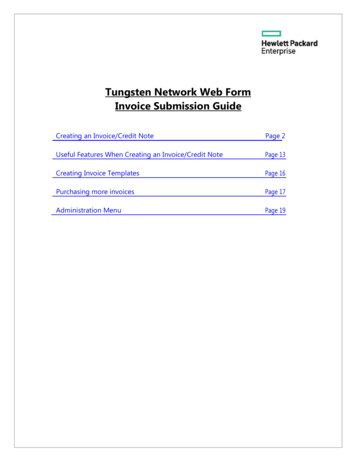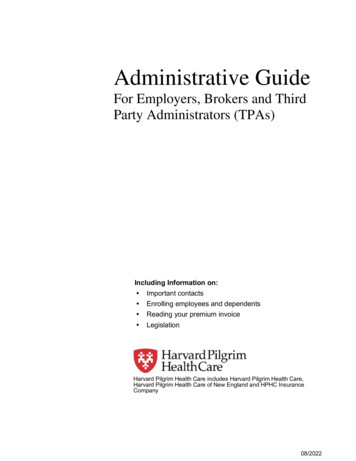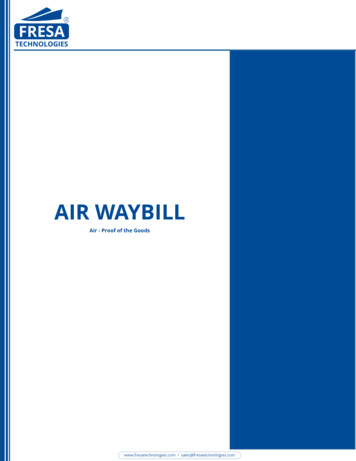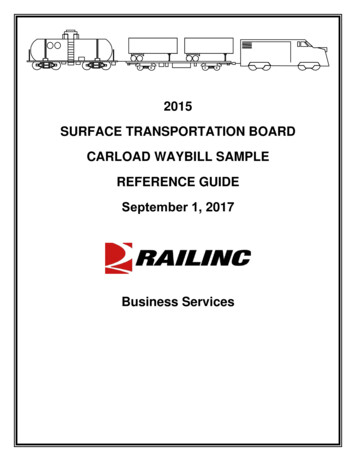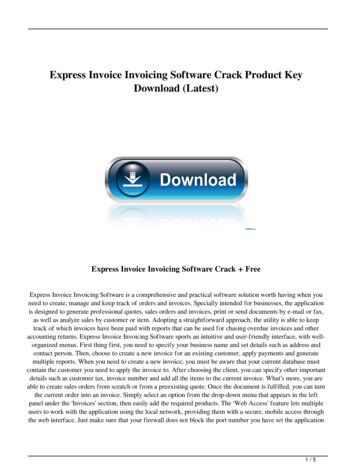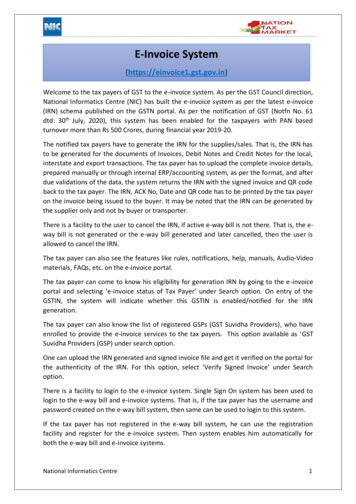
Transcription
E-Invoice System(https://einvoice1.gst.gov.in)Welcome to the tax payers of GST to the e-invoice system. As per the GST Council direction,National Informatics Centre (NIC) has built the e-invoice system as per the latest e-invoice(IRN) schema published on the GSTN portal. As per the notification of GST (Notfn No. 61dtd: 30th July, 2020), this system has been enabled for the taxpayers with PAN basedturnover more than Rs 500 Crores, during financial year 2019-20.The notified tax payers have to generate the IRN for the supplies/sales. That is, the IRN hasto be generated for the documents of Invoices, Debit Notes and Credit Notes for the local,interstate and export transactions. The tax payer has to upload the complete invoice details,prepared manually or through internal ERP/accounting system, as per the format, and afterdue validations of the data, the system returns the IRN with the signed invoice and QR codeback to the tax payer. The IRN, ACK No, Date and QR code has to be printed by the tax payeron the invoice being issued to the buyer. It may be noted that the IRN can be generated bythe supplier only and not by buyer or transporter.There is a facility to the user to cancel the IRN, if active e-way bill is not there. That is, the eway bill is not generated or the e-way bill generated and later cancelled, then the user isallowed to cancel the IRN.The tax payer can also see the features like rules, notifications, help, manuals, Audio-Videomaterials, FAQs, etc. on the e-invoice portal.The tax payer can come to know his eligibility for generation IRN by going to the e-invoiceportal and selecting ‘e-invoice status of Tax Payer’ under Search option. On entry of theGSTIN, the system will indicate whether this GSTIN is enabled/notified for the IRNgeneration.The tax payer can also know the list of registered GSPs (GST Suvidha Providers), who haveenrolled to provide the e-invoice services to the tax payers. This option available as ‘GSTSuvidha Providers (GSP) under search option.One can upload the IRN generated and signed invoice file and get it verified on the portal forthe authenticity of the IRN. For this option, select ‘Verify Signed Invoice’ under Searchoption.There is a facility to login to the e-invoice system. Single Sign On system has been used tologin to the e-way bill and e-invoice systems. That is, if the tax payer has the username andpassword created on the e-way bill system, then same can be used to login to this system.If the tax payer has not registered in the e-way bill system, he can use the registrationfacility and register for the e-invoice system. Then system enables him automatically forboth the e-way bill and e-invoice systems.National Informatics Centre1
Presently, e-Invoice System provides the two modes of IRN generation – Offline and API.The following table provide the different methods involved in IRN generation based on theturnover of the tax payers. The notified tax payers can use these modes for the generationof IRN. The tax payers can also generate the e-way bill along with the IRN in one go orgenerate IRN and the e-way bill later based on the IRN. On generation of IRN, the systemreturns the signed invoice in the JSON format with the QR code, which can be used topreserve and share with the buyers, if required. Please refer to the Annexure for the samplecopy of the invoice along-with QR code on it.There is an option in the website to download a Mobile App (for Android and iOS) whichmay be used to verify the authenticity of the QR code and the contents printed on theInvoice. This app may be used by any taxpayers or any external agencies like banks andother financial institutions for verifying the invoice.The tax payer can also know his/her sister concerns, generating the IRNs and e-way billsusing API, after logging into the portal. This helps him to tie up with his/her sister concernsfor integration of API mode.Before integration with the API on production system, the tax payer needs to do the testingof API integration on the sand-box system (https://einv-apisandbox.nic.in). In the sandboxsystem, the notified tax payer can register and understand the process of IRN integrationand test the integration with his/her own system. The following procedures explain how toon-board on production system for API integration after completion of testing on sandbox.The Tax payers having PAN based turnover more than Rs 500 Crores can use any of thefollowing methods for IRN generation Offline tool - Upload the invoices in standard format and generate the IRN in one goAPI - Through GSPs integration - System-to-system integration using APIs throughregistered GSPsAPI – Direct integration - System-to-System integration using API directly from TaxPayers systemAPI - Through enabled sister concerned GSTIN - System-to-System integration using APIthrough the sister company of the Tax payers having same PAN. If it has been enabledfor API.E-Way Bill API enabled Tax Payers - System-to-System integration using API for alreadyE-Way Bill enabled Tax PayersDetailed Procedures1. Using Offline Tool Please go to the https://einvoice1.gst.gov.in portal and see the procedure for thepreparation of the bulk upload request for IRNs at Help Tools Bulk Generationtools. Once you have prepared the bulk upload request file with the invoices, please loginat the https://einvoice1.gst.gov.in portal. If you have registered in the e-way billportal (https://ewaybillgst.gov.in), then you can use the login credentials (usernameNational Informatics Centre2
and password) of the e-way bill system to login to the e-invoice portal. If you havenot registered in the e-way bill portal, then you can register in the e-invoice portal atoption Registration.On logging into the e-invoice portal, select the e-invoice option and Bulk IRN option.Now, upload your request file and generate the IRNs for your invoices.After generation, the system will also provide the mechanism to download the IRNform with all the details.In case of any errors, the system shows the errors with the requested invoices. Youcan correct them and request once again.2. Using GSPs (GST Suvidha Providers) Before starting to work on this, you need to test the API integration with theidentified GSP in sand-box environment (https://einv-apisandbox.nic.in/). Aftertesting, GSP has to submit the test summary report, as per the format providedunder ‘On Boarding’ at sandbox portal, to the email support.einv.api@gov.in. Afterverification of the test summary report, GSP will be provided the production APIdetails. Please login at the https://einvoice1.gst.gov.in portal.If you have registered in the e-way bill portal (https://ewaybillgst.gov.in), then youcan use the login credentials (username and password) of the e-way bill system tologin to the e-invoice portal.If you have not registered in the e-way bill portal, then you can register in the einvoice portal at option Registration. If you have registered with a GSP for E Way Bill and would like to continue withsame GSP, no need to register for GSP again. Same credentials will work for eInvoice If you have not registered for GSP earlier, on logging into the e-invoice portal, selectthe API registration and select Create API User. Select the GSP being used forgeneration of IRN and EWB and submit. Create API user, by entering username and password and preserve them with you. Use these credentials and generate the token and request for the IRN3. Using Direct Integration Before starting to work on this, you need to test the API integration in sand-boxenvironment (https://einv-apisandbox.nic.in/). After testing, tax payer has to submitthe test summary report, as per the format provided under ‘On Boarding’ atsandbox portal, to the email support.einv.api@gov.in. After verification of the testsummary report, tax payer will be provided the production API details. Please login at the https://einvoice1.gst.gov.in portal.If you have registered in the e-way bill portal (https://ewaybillgst.gov.in), then youcan use the login credentials (username and password) of the e-way bill system tologin to the e-invoice portal.If you have not registered in the e-way bill portal, then you can register in the einvoice portal at option Registration. If you have already integrated with API under e-Waybill system, then you can usethe same API credentials for e-Invoice systemNational Informatics Centre3
If not, then select the option IP Whitelisting under API Registration. Enter theproduction IPs that need to be whitelisted and submit.The network team will scrutinize and whitelist the IP addresses.Next, select Create API User and enter your credentials. On registration you willreceive Client-Id and Client-Secret.If your sister concern (having same PAN) has already registered for API andwhitelisted IP, you can use the same Client-Id credentials. You only need to registerAPI User.4. Using API integration with sister concern GSTIN Before starting to work on this, you need to test the API integration in sand-boxenvironment (https://einv-apisandbox.nic.in/). After testing, tax payer has to submitthe test summary report, as per the format provided under ‘On Boarding’ atsandbox portal, to the email support.einv.api@gov.in. After verification of the testsummary report, tax payer will be provided the production API details. The public IP used by your company and sister concern should be same, whenaccessing the e-invoice and e-way bill production APIs. Please login at the https://einvoice1.gst.gov.in portal.If you have registered in the e-way bill portal (https://ewaybillgst.gov.in), then youcan use the login credentials (username and password) of the e-way bill system tologin to the e-invoice portal.If you have not registered in the e-way bill portal, then you can register in the einvoice portal at option Registration. If you have already integrated with API under e-Waybill system, then you can usethe same API credentials for e-Invoice system Otherwise, please log into the e-invoice portal, select the API registration and selectCreate API User. Select the sister concern GSTIN and submit. Create API user, by entering username and password and preserve them with you. Now, with your API user credentials and client-id credentials of the sister concern,you can connect and generate the IRN and EWB.5. Using E-way Bill API credentials Before starting to work on e-invoice system, you need to test the API integration insand-box environment (https://einv-apisandbox.nic.in/). After testing, tax payer hasto submit the test summary report, as per the format provided under ‘On Boarding’at sandbox portal, to the email support.einv.api@gov.in. After verification of the testsummary report, tax payer will be provided the production API details. If you have already integrated with API under e-Waybill system, then you can usethe same API credentials for e-Invoice system. No other steps need to be followed. Use the e-way bill purpose whitelisted IPs to access the e-invoice system.For more details watch these videos123Introduction to e-Invoice SystemIRN Generation using Bulk ToolsProcess for API RegistrationNational Informatics Centre4
4e-Invoice API Sandbox SystemAnnexureSAMPLE E-INVOICE PRINTNational Informatics Centre5
If you have already integrated with API under e-Waybill system, then you can use the same API credentials for e-Invoice system. No other steps need to be followed. Use the e-way bill purpose whitelisted IPs to access the e-invoice system. For more details watch these videos 1 Introduction to e-Invoice System
